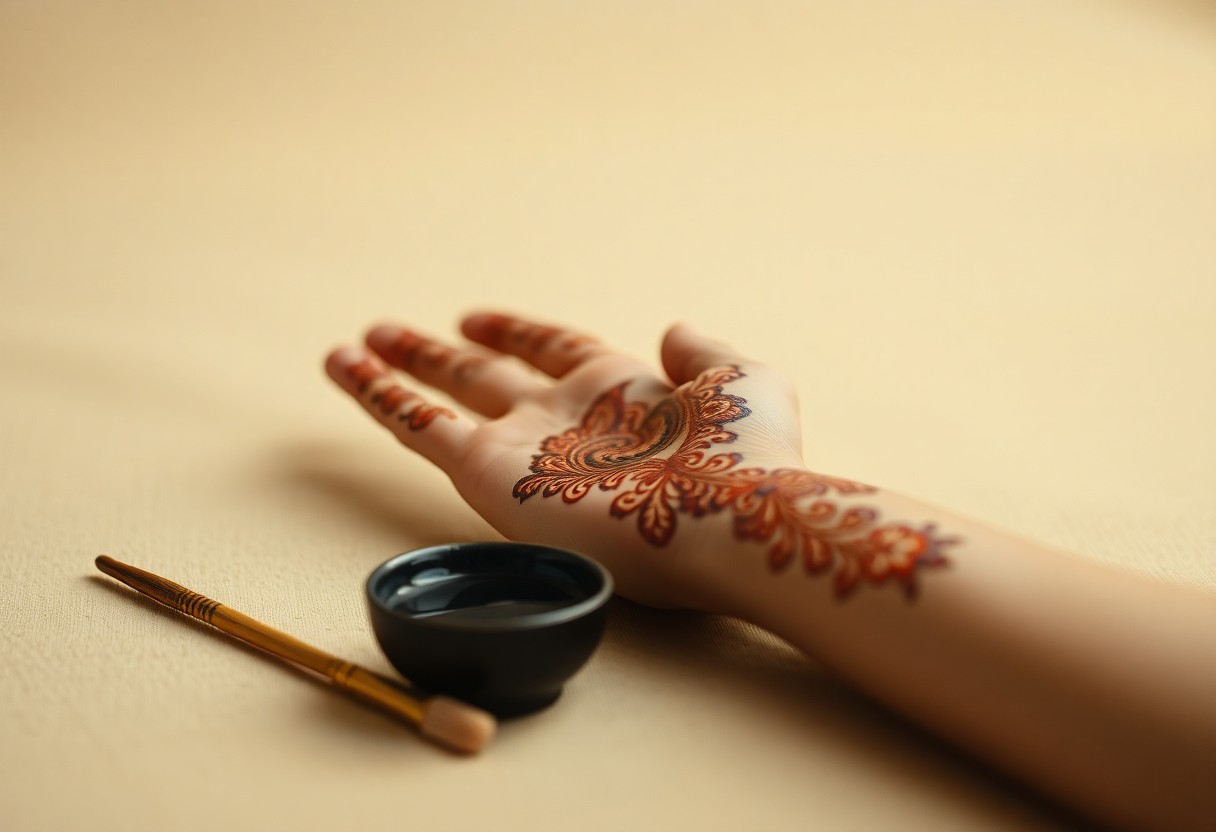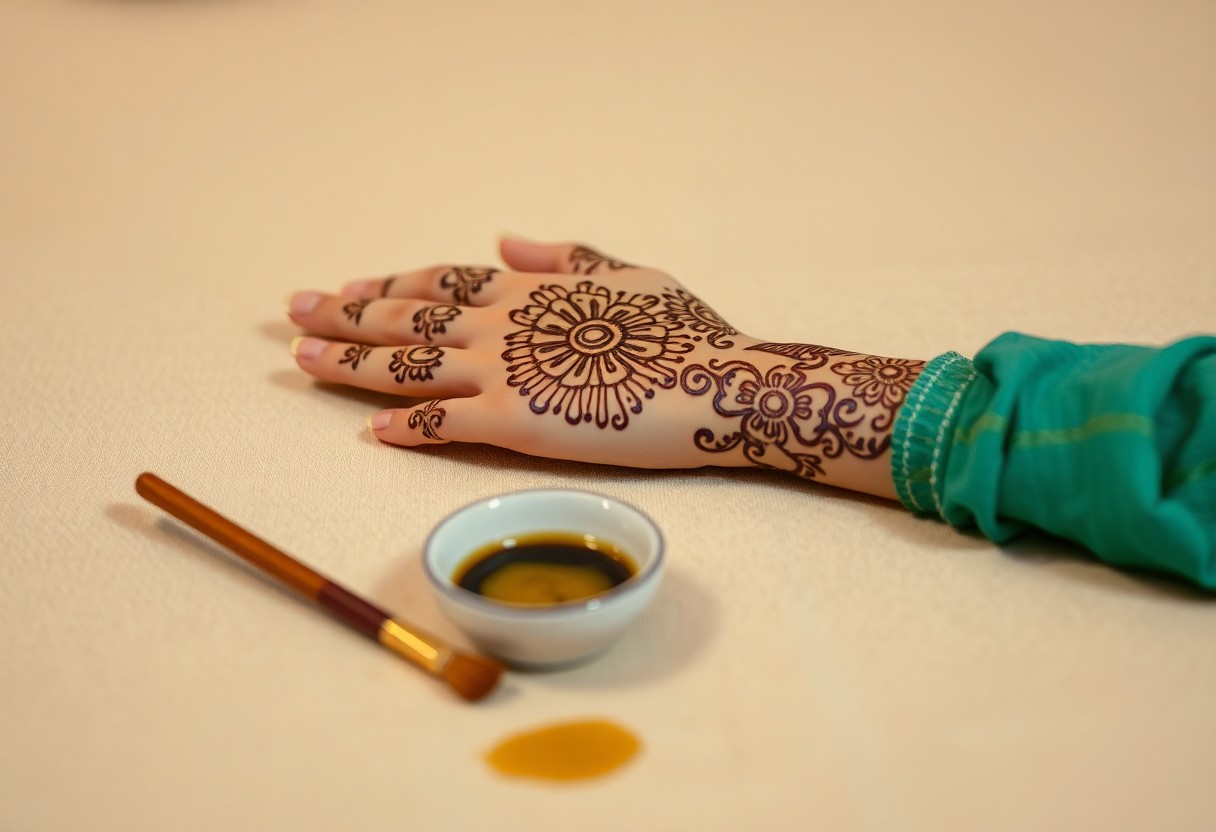Many people seek to enhance the beauty of their mehndi designs by achieving a darker stain. To help you achieve that rich, deep color, this guide covers effective techniques and natural remedies that can make a noticeable difference. Understanding the right application methods and aftercare practices are key to ensuring your mehndi lasts longer and appears darker. Follow these simple steps to enhance your mehndi and impress with stunning designs that stand out beautifully on your skin.
Table of Contents
Key Takeaways:
- Selecting Quality Paste: Use high-quality mehndi paste for better color development.
- Application Techniques: Apply a thick layer of mehndi and keep it on for a longer duration to achieve a deeper shade.
- Post-Application Care: Use natural oils, lemon juice, or sugar to enhance and lock in the color after removing the paste.

Understanding Mehndi
A deep understanding of mehndi will enrich your experience and appreciation of this beautiful art form. Mehndi, often associated with cultural and traditional ceremonies, is the application of a natural dye made from the leaves of the henna plant. It has been used for centuries to create intricate designs on the skin, treasured for its aesthetic and symbolic values.
What is Mehndi?
You may know mehndi as body art, but it’s more than just a decorative element. This ancient practice involves applying a paste made from crushed henna leaves onto the skin, where it leaves a temporary stain that varies in color and intensity, influenced by various factors such as skin type and application techniques.
Historical Significance
If you examine into the history of mehndi, you’ll discover it has deep roots in various cultures, particularly in South Asia and the Middle East. Historically, mehndi was used not only for beauty but also as a symbol of good fortune, celebration, and joy during significant life events such as weddings and festivals.
It played a significant role in traditional practices, with its use dating back thousands of years. The symbolism associated with mehndi is rich; it is believed to bring prosperity and blessings to newlyweds and to ward off negative energies. Moreover, the intensity and design of the mehndi can represent personal experiences or family heritage, creating a connection to one’s cultural identity.

How to Prepare the Mehndi Paste
If you want your mehndi to exhibit rich colors and longevity, proper preparation of the paste is imperative. Start with fresh, high-quality henna leaves or powder, and mix it with natural ingredients that will enhance the final color. Keep in mind that the right consistency and texture will allow for a smooth application, providing precise and intricate designs.
Selecting Quality Ingredients
Clearly, the quality of your henna is paramount to achieving the best results. Opt for organic or natural henna powder free from chemicals, which often lead to unpredictable results and potential skin irritation. Also, incorporate natural additives like lemon juice and sugar to improve the paste’s adherence and color payoff.
Mixing Techniques
Ingredients you’ll need for a successful mehndi paste include henna powder, lemon juice, sugar, and imperative oils.
Mehndi mixing is an art in itself. The key is to create a paste with a smooth, creamy consistency that’s not too thick or too runny. Begin by mixing the henna powder with lemon juice, gradually adding sugar for moisture and a few drops of an imperative oil like eucalyptus for enhanced color release. Allow the mix to sit for several hours to activate the dye, resulting in a rich color once applied to your skin. These elements combined will ensure that your henna stains dark and long-lasting, while also keeping your skin healthy.
Application Techniques
Keep in mind that the way you apply mehndi can significantly influence its darkness and longevity. To achieve the best results, consider using a fine cone for detailed designs and make sure to use an even pressure while applying the paste. Let your creativity flow, and don’t rush, as precision leads to richer colors.
Proper Skin Preparation
Even the best mehndi will not yield rich results if your skin is not properly prepared. Cleanse the area where you will apply the henna with soap and water to remove any oils or dirt. Exfoliating the skin beforehand can also help enhance color absorption, making the mehndi stain darker.
Detailed Application Methods
One effective method for a deep, dark hue is to use multiple layers of mehndi. Applying a thick layer and allowing it to dry completely before layering more can significantly enhance the stain. Additionally, focusing on intricate patterns allows the paste to have more contact with your skin, which leads to deeper coloration.
Preparation is key when considering detailed application methods for mehndi. Start by having all your tools ready and the henna mixture prepared to the right consistency, ensuring it’s not too runny or thick. Working on a clean, dry surface is imperative, as moisture can dilute the paste and affect adhesion. Applying the mehndi in a warm environment can also assist in achieving a darker stain, as it enables better dye release. Finally, keeping the paste on your skin for a significant amount of time before removal enhances the depth of the color; this method can be time-consuming but rewarding in your quest for the perfect mehndi stain.
Tips for Darkening Mehndi
Now, to ensure your mehndi achieves a deep and rich color, consider the following tips:
- Apply lemon juice and sugar after drying for added tint
- Use heat to enhance the design’s darkness
- Keep your mehndi on for a longer duration for improved results
- Moisturize with coconut oil post-application
Thou shall follow these practices for mesmerizing mehndi that lasts longer.
Environmental Factors
If you want an optimal mehndi experience, it’s crucial to consider the following environmental factors:
- Humidity can affect the drying time, influencing color
- Sunlight exposure can hasten the drying process, aiding stain quality
- Temperature plays a role in the reaction of the mehndi with your skin’s chemistry
Perceiving these factors will help you achieve the desired mehndi shade.
Aftercare Practices
With the right aftercare, you can enhance the longevity and depth of your mehndi design. Make sure to avoid water for the first few hours and keep the area warm and dry to allow the stain to develop, as moisture can hinder the darkening process.
Plus, applying crucial oils like eucalyptus or clove oil post-application can enhance the darkness of your mehndi. Additionally, avoid scrubbing the design and refrain from perfumed products, as these can lift the color. A well-cared mehndi stays vibrant and shows the beauty of your art!
Factors Influencing Color Intensity
Once again, the depth of your mehndi color can be significantly affected by several factors such as:
- Quality of henna
- Skin type
- Application technique
- Duration of exposure
- Climate conditions
The right combination of these elements will lead to a richer, darker tint.
Skin Types
Color intensity differs across various skin types. You might find that:
- Oily skin retains darker hues
- Dry skin may appear lighter
- Warm undertones enhance the hue
- Cold undertones can dampen the color
- Skin pH levels impact absorption
Perceiving these variations can help you achieve the desired mehndi effect.
| Factor | Impact on Color |
| Quality of Henna | Influences richness of color |
| Skin Type | Affects the final color depth |
| Application Technique | Determines evenness and saturation |
| Duration of Exposure | Longer exposure deepens the hue |
| Climate Conditions | Can enhance or fade the color |
Duration of Application
Now, the length of time you let mehndi rest on your skin plays a significant role in the final color outcome.
Plus, leaving the mehndi on for an extended period, ideally 6 to 8 hours, allows for maximum dye release. Always ensure you apply it in a protected environment to prevent smudging, and avoid washing the area for better results. Inhaling or applying substances like lemons or sugar can help lock in the moisture, allowing deeper penetration of the dye into your skin. Also, avoid heat sources during this time, as excessive warmth can interfere with the color bonding process.
Alternatives to Enhance Color
Unlike traditional methods, there are various alternatives to enhance the color of your mehndi. You can explore natural and commercial options to achieve a darker stain. Each of these methods brings its own unique properties, and understanding them can help you make an informed choice that suits your preferences and skin type.
Natural Enhancers
Assuming you’re looking for safe and organic options, there are several natural enhancers you can use. Ingredients like lemon juice, sugar, or even vital oils can be applied to your mehndi once it has dried. These will assist in deepening the color while ensuring that you nourish your skin during the process.
Commercial Products
You might consider commercial products specifically designed to enhance mehndi color. These solutions often come with strong chemical components, which can vary in effectiveness and safety. Always check the ingredients to avoid any harmful substances that could irritate your skin.
With a variety of commercial products available, you can find options such as mehndi oils or color enhancers that promise a richer stain. It’s vital to choose products from reputable brands and read the instructions carefully to prevent any allergic reactions. Some products might contain harmful chemicals, so opting for those labeled as skin-friendly will offer a more positive experience. Test a small area first to ensure your skin tolerates the product well.
Final Words
As a reminder, to achieve a richer, darker mehndi stain, you can utilize natural remedies and some care techniques. Your skin type, the quality of the henna, and how you treat your mehndi post-application all play roles in the final color. Experiment with methods such as using important oils or keeping the mehndi on longer. For a comprehensive guide, consider checking out the 10 Most Useful Tips To Darken Mehndi that can enhance your experience and results.
FAQ
Q: What are the best natural ingredients to darken mehndi?
A: To enhance the darkness of mehndi, you can use various natural ingredients. Common options include lemon juice and sugar, which help to intensify the color. Mix equal parts of lemon juice and sugar to create a paste, and apply it over the dried mehndi design after it has set for a few hours. Other options include applying eucalypt oil, which can aid in deepening the color. Additionally, you can use tea or coffee rinses to create a darker stain by spraying or dabbing the liquid onto the dried henna.
Q: How long should I leave the mehndi on for the darkest color?
A: For the richest and darkest color, it is advisable to leave the mehndi on for at least 6 to 8 hours. Some people even prefer to leave it overnight for maximum stain absorption. The longer the mehndi stays on the skin, the deeper the color will get as it oxidizes. After removing the mehndi, it is recommended to avoid washing the area for 24 hours to allow the color to further darken and set.
Q: Does the type of henna powder affect the darkness of the stain?
A: Yes, the type of henna powder you use can significantly affect the stain’s darkness. High-quality henna, typically from regions like Rajasthan or Yemen, offers richer pigments and produces a deeper color compared to lower-quality or synthetic henna. Look for henna that is fresh and has a fine powder texture. Additionally, organic henna without any additives tends to yield better results in terms of darkening color.